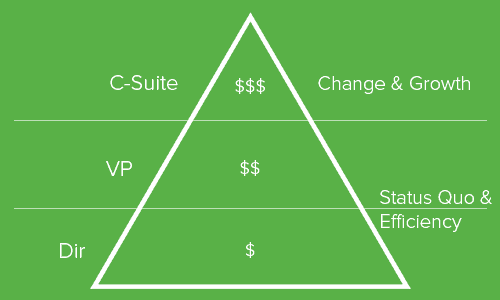
Making a bad hire is a huge cost to a company. How can teams ensure they’ll attract and filter the right candidates for a sales role? (10 minute read).
One of the hardest roles to fill is that of the sales rep. Today, sales professionals hold the #1 most in-demand role out of all job functions, surpassing even engineers (according to LinkedIn research; Manpower Group ranks them as #2). Overall talent shortages are at their highest since 2006, which is a dire situation for employers.
Not only is it difficult to get salespeople in the door, but their success isn’t guaranteed. Nearly 50% of sales reps don’t meet quota, and a bad hire can be extremely costly in terms of lost revenue opportunity, external brand damage, and the negative effects on team morale.
This is why it is so important for companies to learn how to attract top salespeople, and to design an appropriate hiring process to do so. In this article, we will share insights about how to find higher-quality candidates and vet them in a way that increases their chances of sustained success.
A real hiring process includes much more than a simple job posting and interview. There’s much behind-the-scenes preparation that hiring managers can undertake to increase the chances of success before a candidate even comes in for a conversation. We’ll cover:
- Preparing for the hire: Gathering resources for compensation and support
- Defining the ideal hire and writing the job description
- Building a candidate pipeline
- Interviewing with a guide and rubric
- Beyond the offer letter
Sales hiring requires a unique approach and we will offer sales-specific insights into the hiring processes we’ve helped to build at hundreds of companies across North America, with thousands of candidates evaluated.
Preparing for the hire: Gathering resources for compensation and support
There’s more to employing a successful salesperson than just the hire itself; salespeople also need the right environment and support systems to deliver on their goals. Before creating a job description or speaking with candidates, the company—and the existing sales team— must be ready to receive them. This means ensuring that such executives as the CFO, Head of HR, CMO, and CEO (the key players for scaling a sales team) are all on board, to allocate the necessary resources: sales operations support, technologies, training, and compensation.
Allocate competitive compensation
Top performers are not easy to find, nor are they easy to attract; typically, they are already gainfully employed and delivering results in their current role. But they are worth the effort and the budget, because they are much more likely to deliver on revenue goals, to inspire customer confidence and brand appreciation, and to contribute significantly to positive team culture.
An attractive compensation package can help bring in this top talent. It can also increase retention and incentivize desired behaviors. Companies need to understand the compensation package required to attract top candidates and to make sure the team has budgeted accordingly; this means knowing the current market base salary and on-target earning (OTE) rates, as well as bonuses and accelerators. It also means considering which non-monetary benefits can be offered, including vacation, flex time, training, mentorship, and prospects for career advancement.
In our 2019 Sales Compensation Study, we have found that 29% of top sales performers are not satisfied with their current compensation, and 54% are dissatisfied with their employer. Among all respondents—not just the top performers—38% felt that their compensation was below the industry average.
This gives employers an opportunity to differentiate themselves, and suggests that compensation should be thought of as not just a standalone financial incentive, but as leverage for a broader initiative to increase employee satisfaction and retention. It is a strategic lever that should be considered at the beginning of the hiring process, budgeting appropriately and allocating resources before setting out to interview candidates.
Prepare sales process documentation and operational support
When a top candidate comes in for an interview, they will be evaluating a new workplace for indicators that it will support their ongoing success.
Consequently, a sales team should check for the following things, which a candidate will also be looking for:
- Are there onboarding processes, playbooks, and documentation set up and ready for the candidate to ramp up?
- Is the sales process itself well documented and successful? Top candidates will often look at a new employer’s sales process as a key indicator of whether to take the sales organization seriously. A properly implemented sales process can improve win rates by 24%, reduce sales cycle length, and increase average sale price.
- Is the sales and marketing automation technology up to date?
- What systems are in place to minimize administrative and customer support work that is beyond the scope of the job role?
- How many people are dedicated to sales support functions, including territory creation, forecasting, funnel management, coaching, admin work, technology management, and culture building? (Research suggests that to optimize sales team ROI, 50%–60% of sales employees should be dedicated to support functions.)
If the proper sales process, training, and onboarding resources are unavailable, consider adjusting the hiring timeline.
Defining the ideal hire and writing the job description
The next step is to define exactly what type of hire is needed, and to establish the evaluation methodologies that will screen the right people in or out.
Understanding why a new hire is necessary helps pinpoint the exact characteristics and experience the ideal candidate should have; brainstorming sessions with the team can help clarify the intrinsic characteristics required for the job. Does the team need someone to generate new business, or upsell existing customers? Is the business looking to enter a new market this year, or perhaps a new market segment that requires a focused and dedicated salesperson? Is the business rolling out new products or services?
If possible, conversations with customers can also be helpful. Understanding the successful and unsuccessful relationships that customers have had with salespeople can give valuable insights into specific requirements and expectations for the job description. What has helped customers make a decision to buy? What has resonated? What was the frequency and nature of the communication?
Teams should look for candidates that possess the general traits we call Sales DNA. These are the typical characteristics that drive high-achieving salespeople and are excellent predictors of success. They include ambition, competitiveness, a sense of urgency, confidence, perseverance, optimism, resilience, ability, and the desire to influence others.
Sales DNA traits, as well as team-specific traits, tend to predict success much more reliably than “gut feel” or even a candidate’s resume. (We have seen that Sales DNA beats the resume.)
Take an example from one of the most noteworthy contemporary sales leaders in tech, who uses quantitative measures to predict performance and hire accordingly. Mark Roberge scaled his sales team at HubSpot by running a regression analysis. He found the candidate traits that correlated with sales success at his company, based on 500 interviews and 12 hires over a year. By pinpointing these characteristics and creating a quantitative hiring process around them, Roberge was able to predictably hire the same (successful) salesperson over and over.
“Gut feelings” tend to be poor predictors of long-term sales performance and are vulnerable to unconscious bias. For this reason, sales hiring should be objective and quantitative wherever possible. Codify your requirements into scoring rubrics to make interviews structured and objective (rather than open-ended). Seek out quantitative psychometric tests and assessments which identify a candidate’s aptitudes, key motivators, and behavioral skill sets, and which help a team home in on the true predictors of success.
Companies that use hiring tools to assess candidates have a higher percentage of reps that meet quota, have more confidence in their sales organization, and show higher rates of retention, according to research by CSI Insights. In fact, research shows that unstructured hiring methods are so poor at delivering high-caliber salespeople that companies may be better off selecting candidates at random.
Once the specific needs for the position are identified, it’s time to write the job description.
Writing the job description
The job description should give a sense of the culture and values of the business and sales team, integrating the brand voice and tone rather than being just a cut and dried list of responsibilities.
It should include a comprehensive list of perks and benefits to provide an idea of the company’s environment, values, and positive attitude toward employees. This is part of the jobs’ non-monetary offering; top performers want to be in a positive environment surrounded by excellence and opportunities for advancement, and the job description is a good way to show this off.
See an example of an Account Executive job description.
Specificity is key. Instead of stating that a team seeks an “energetic” candidate—a term that really is just filler material—the exact responsibilities, duties, and expectations in a typical sales cycle should be addressed. Will the sales rep be tasked with generating new business and hitting a quota of new sales? Are their core success metrics centered around client retention or upselling existing clients? How many calls or site visits does the role require?
And, of course, the description should be free from grammatical errors.
Once the job requirements are created, it’s time to hunt for great candidates.
Building a candidate pipeline
The trick to great sales hiring is to start early and nurture candidates over months or years—just like a salesperson might nurture a customer. If a company uses a sales funnel for customers, it should use a recruiting funnel for candidates. A recruiting funnel allows teams to systematically find leads and build relationships until they’re ready for an interview.
This is the best way to attract top performers, who usually are not searching job boards for open positions because they’re busy performing well in their current job. This is why companies who want A-player talent must hunt them proactively and take time to nurture them over the long term, engaging them with events, content marketing, and one-on-one outreach over time.
If this nurturing is done correctly, top candidates will be ready for more serious conversations when a job position opens, avoiding a last-minute scramble for B- or C-grade performers. It’s similar to a soccer coach who has great players on the bench, ready to jump into a game when they’re needed.
Companies can search for candidates on alternative channels such as social networks like LinkedIn, conferences, and industry events. (Here’s a guide to using online social networks to find top talent.)
Teams should also mine their own networks for referrals, which are the #1 source of high-quality hires. In particular, the current top performers at a company tend to have deep networks of other excellent salespeople. Companies can also extend their reach with recruiting firms.
Hiring managers should use an applicant tracking system (ATS) or even a simple Google spreadsheet tracker as a CRM, to keep tabs on candidates and the outreach they have received. They can refer to it periodically and reach out at regular intervals to nurture relationships.
Part of the nurture process is the slow task of communicating the benefits and selling points of the team to a candidate. In other words, it can require content marketing and employer branding.
To improve employer branding, a company can think about candidate touchpoints—like the hiring pages on their website—and update them to highlight a desirable work-life balance, the benefits of the working environment, the company vision, and the opportunities for a candidate to contribute to a growth story.
New touchpoints can be added as well, such as an email newsletter specifically for candidates, retargeting ads, and in-person events.
Content marketing for candidates can include:
- Job opportunity alerts for candidates who subscribe to them
- Newsletters aimed at candidates or interested followers
- Stories that profile outstanding employees at the company
- Stories about culture and team events
- Glassdoor ratings
- Invitations to in-person events
- Industry news
- News about a company’s high-visibility partnerships and customers
This type of content can educate a candidate about team culture, build interest and trust, and keep a company at the top of their mind over the long term.
If done correctly, the recruiting funnel will produce prospective candidates that are ready to become interviewees as positions open.
Interviewing with a guide and rubric
The interview stage is the final filter for candidates.
Create an interview guide and rubric
As previously mentioned, it’s important to keep interviews as objective and structured as possible, with the same set of criteria used in the evaluation of all candidates.
A set of interview questions should be developed in advance and the core set of questions maintained for each candidate, no matter who the interviewers are. Role-playing can be used to test a candidate’s responses to objections, their needs-finding abilities, and their customer empathy.
A rubric can be used to score the answers. For a sample rubric and interview template, as well as a list of core questions, legal guidelines, and common pitfalls, see our guide to conducting successful sales interviews. Psychometric assessments can be used to test for Sales DNA and other required traits, and a search firm can assist with setting them up.
Ultimately, a salesperson is being hired to sell products and services that will solve client problems, so the interviewer should notice how the candidate seeks to understand the business problems facing the hiring company and its competitors, and the skills they can bring to solve them. If the candidate is simply listing out their skills and past performance metrics, that’s a red flag. Candidates should know their business impact and numbers cold, but they must also have outstanding storytelling skills to sell themselves and be able to relate their experience to the company’s position in the marketplace.
Meanwhile, interviewers and the hiring manager should be selling the company, the team, and its values to the candidate. Star sales reps are likely to have multiple offers, and they will be using the interview as an opportunity to determine which company is the right fit for them.
Beyond the offer letter
If a candidate makes it through the interviews and scores well on the assessment rubrics, it’s time to make an offer. Ideally, a competitive compensation package is ready to go.
Hiring managers should ensure that an effective onboarding process is in place to get the new salesperson up to speed and delivering value quickly. Onboarding plans should map out a new hire’s first 90 days, with 30-, 60-, and 90-day goals that use metrics to define what success looks like at each milestone. (For guidance on what to include in a sales onboarding plan, read more at Faster, Better Sales Onboarding and The Six Elements of an Effective Sales Onboarding Program.)
It can be tempting for hiring managers to jump into interviews as soon as a job position opens, but they should first take the time to prepare an end-to-end recruiting process. This upfront work includes:
- Gaining organizational alignment
- Understanding and securing appropriate compensation for a top performer
- Identifying specific requirements for the position as opposed to casting a wide net
- Creating a rigorous, codified, structured candidate evaluation system for interviews and other assessments
- Building a recruiting funnel with a great employer brand
- Nurturing top-performing candidates over the long term until they are ready for an interview.
A well thought out process attracts higher-quality candidates who will be more likely to succeed over the long term. When a top-performing candidate steps into a company’s universe—whether for an interview or simply to visit the company website—they will scrutinize it carefully. And the sales team should be ready.
With these preparatory steps, hiring managers can avoid spinning their wheels and losing time, or worse, attracting costly, poor performers. Sales talent is costly either way, so it’s worth concentrating only on the top-drawer variety.
relpost-thumb-wrapper
Related posts
close relpost-thumb-wrapper
Eliot Burdett
Latest posts by Eliot Burdett (see all)
- 20 Of Our Favorite Books About Sales Management and Sales Leadership – October 20, 2023
- How To Make Progress On Your Sales Goal Without A Sales Leader – September 15, 2021
- Augment Your Recruiting Strategy During “The Great Resignation” – July 26, 2021














 The economy is creeping along. Revenue is down, the pressure is on to reduce overhead and the CFO is looking at the way you sell. You can choose from a variety of job candidates: full time staff, freelancers, independent contractors, temps and consultants. Now the big question, do you continue with a full time sales staff or outsource for sales agents?
The economy is creeping along. Revenue is down, the pressure is on to reduce overhead and the CFO is looking at the way you sell. You can choose from a variety of job candidates: full time staff, freelancers, independent contractors, temps and consultants. Now the big question, do you continue with a full time sales staff or outsource for sales agents?